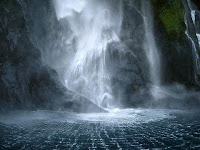Milford Sound is an inlet in the south west of New Zealand South Island, within Fiordland National Park and the Te Wahipounamu World Heritage site. It has been judged the world's top tourist travel attraction in an international survey, and New Zealand most famous tourist destination. Rudyard Kipling had previously called it the eighth Wonder of the World. Milford Sound is named after Milford Haven in Wales, while the Cleddau River which flows into the sound is also named for its Welsh namesake.
 Milford Sound runs 15 kilometres inland from the Tasman Sea and is surrounded by sheer rock faces that rise 1,200 metres or 3,900 ft or more on either side. Among the peaks are the Elephant at 1,517 metres or 4,980 ft, said to resemble an elephant's head, and Lion Mountain, 1,302 metres or 4,270 ft, in the shape of a crouching lion. Lush rain forests cling precariously to these cliffs, while seals, penguins, and dolphins frequent the waters and whales can be seen sometimes. The annual rainfall of 6,813 mm on 182 days a year, a high level even for the West Coast, Milford Sound is known as the wettest inhabited place in New Zealand. Rainfall can reach 250 mm during a span of 24 hours. The rainfall creates dozens of temporary waterfalls cascading down the cliff faces, some reaching a thousand metres in length.
Milford Sound runs 15 kilometres inland from the Tasman Sea and is surrounded by sheer rock faces that rise 1,200 metres or 3,900 ft or more on either side. Among the peaks are the Elephant at 1,517 metres or 4,980 ft, said to resemble an elephant's head, and Lion Mountain, 1,302 metres or 4,270 ft, in the shape of a crouching lion. Lush rain forests cling precariously to these cliffs, while seals, penguins, and dolphins frequent the waters and whales can be seen sometimes. The annual rainfall of 6,813 mm on 182 days a year, a high level even for the West Coast, Milford Sound is known as the wettest inhabited place in New Zealand. Rainfall can reach 250 mm during a span of 24 hours. The rainfall creates dozens of temporary waterfalls cascading down the cliff faces, some reaching a thousand metres in length.The beauty of this landscape draws thousands of visitors each day, with over 550,000 in total per year. This makes the sound one of New Zealand's most-visited tourist spots, and also the most famous New Zealand tourist destination, even with its remote location and the long journey from the nearest population centres. Almost all tourists going to the sound also take one of the boat tours which usually last between 1–2 hours. They are offered by several companies, departing from the Milford Sound Visitors' Centre. There is also the option of extended overnight cruises on Milford Sound.

 Tramping, canoeing and some other water sports are also possible. A small number of companies also provide overnight boat trips. There is otherwise only limited accommodation at the sound and only a very small percentage of tourists stay more than the day. An underwater tourist observatory found in one of the bays of the sound provides viewing of black coral, usually only found in much deeper waters. A dark surface layer of fresh water, stained by tannins from the surrounding forest, allows the corals to grow close to the surface here.In rainy and stormy days tourists can admire the play of the wind with the numerous waterfalls in Milford Sound. When meeting the cliff face the powerful wind often goes upward and waterfalls with a vertical drop get caught by wind, causing the water to go upwards.
Tramping, canoeing and some other water sports are also possible. A small number of companies also provide overnight boat trips. There is otherwise only limited accommodation at the sound and only a very small percentage of tourists stay more than the day. An underwater tourist observatory found in one of the bays of the sound provides viewing of black coral, usually only found in much deeper waters. A dark surface layer of fresh water, stained by tannins from the surrounding forest, allows the corals to grow close to the surface here.In rainy and stormy days tourists can admire the play of the wind with the numerous waterfalls in Milford Sound. When meeting the cliff face the powerful wind often goes upward and waterfalls with a vertical drop get caught by wind, causing the water to go upwards.Milford Sound is 295 km from Queenstown and 279 km from Invercargill which is four hours drive with most of the tour buses to the sound departing from Queenstown. Some tourists also arrive from the smaller tourism centre of Te Anau, 121 km away. There are also scenic flights by light aircraft and helicopter tours to and from Milford Sound Airport. The winding mountain road, while of high standards, is very prone to avalanches and closures during the winter. Today many shortcuts to Milford Sound from Queenstown have been mooted, including a gondola route, a new tunnel from Queenstown, or a monorail from near Lake Wakatipu to Te Anau Downs. All would reduce the current round-trip duration thus allowing tourism to be spread out over more of the day.







No comments:
Post a Comment